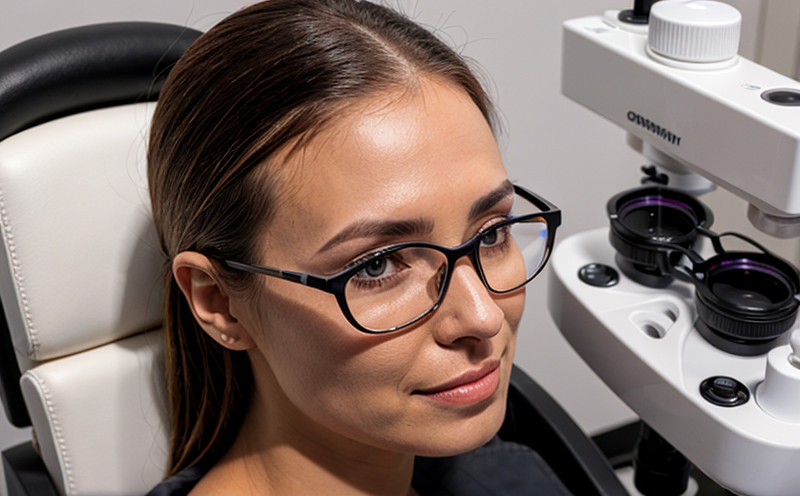ASTM F2338 Vacuum Decay Leak Detection Testing
The ASTM F2338 vacuum decay leak detection test is a critical procedure used to evaluate the integrity of ophthalmic products, particularly those that are sealed or filled with gases. This test ensures that medical devices such as intraocular lenses (IOLs) and other ocular inserts maintain their gas-tight seals throughout their lifecycle. The ASTM F2338 standard specifies the methodology for detecting leaks using a vacuum decay approach.
The process involves placing the ophthalmic product in a vacuum chamber, where it is gradually evacuated to a specified pressure level. The rate at which the pressure inside the sealed container decreases over time is monitored. A leak will result in a faster-than-expected drop in pressure as gas escapes from the sealed component. By comparing this decay rate against pre-defined thresholds, the test determines whether the product meets the required standard for leak tightness.
This testing method is particularly valuable because it can detect very small leaks that might not be apparent through other means. This ensures patient safety and regulatory compliance by confirming that the device remains sealed as intended. The ASTM F2338 specifies a series of steps to ensure accurate results, including calibration of equipment, correct specimen preparation, and consistent testing conditions.
The test is widely used in the pharmaceutical sector, particularly within ophthalmology, where maintaining the integrity of devices can be critical for their function and patient safety. The standard covers both small-scale laboratory tests and large-scale quality control processes, making it a versatile tool in the development and manufacturing stages of ocular products.
For instance, during the research and development phase, this test helps ensure that prototypes meet the necessary leak tightness criteria before moving to production. In manufacturing, it is used for process validation and ongoing quality assurance. During the supply chain, it ensures that products are sealed as intended, thereby preventing contamination or leakage of critical components.
The ASTM F2338 standard is often referenced in conjunction with other standards such as ISO 10993-17, which covers biocompatibility testing for medical devices. The combination of these tests provides a comprehensive approach to ensuring the safety and efficacy of ophthalmic products.
It's important to note that while ASTM F2338 is primarily focused on vacuum decay leak detection, other standards like ISO 15227-9 can be used in conjunction for additional testing parameters. These complementary tests help ensure a holistic approach to product quality and safety.
Eurolab Advantages
EuroLab offers comprehensive support for ASTM F2338 vacuum decay leak detection testing, providing expertise that enhances the reliability of your ophthalmic products. Our team of experienced engineers and scientists ensures that every step of the process adheres strictly to the standard, from specimen preparation to final analysis.
- Comprehensive Testing Capabilities: We have the equipment and expertise to perform ASTM F2338 tests on a wide range of ophthalmic products.
- Expertise in Regulatory Compliance: Our team is well-versed in the latest regulatory requirements, ensuring that your products meet all necessary standards.
- Consistent Results: EuroLab’s state-of-the-art facilities and rigorous quality control processes guarantee accurate and consistent test results.
- Supportive Consulting Services: Our professionals can provide guidance on how to integrate ASTM F2338 testing into your product development lifecycle, enhancing both efficiency and compliance.
EuroLab’s commitment to excellence ensures that every product we test meets the highest standards of integrity and safety. This is crucial for maintaining trust with healthcare providers and ensuring patient satisfaction.
Quality and Reliability Assurance
The ASTM F2338 vacuum decay leak detection test plays a pivotal role in quality assurance by providing objective data that can be used to make informed decisions about the integrity of ophthalmic products. The process involves several key steps, each designed to ensure accurate and reliable results:
- Specimen Preparation: Proper preparation is crucial for ensuring accurate test results. Specimens must be cleaned thoroughly, free from any contaminants that could interfere with the vacuum decay process.
- Vacuum Chamber Calibration: The vacuum chamber used in this testing procedure must be calibrated to ensure consistent and accurate pressure readings throughout the test.
- Pressure Decay Monitoring: During the test, the rate of pressure decay is monitored. A sudden or unexpected drop could indicate a leak, while stable readings suggest integrity.
- Data Analysis: The data collected during the test is analyzed to determine whether the product meets the specified standards for leak tightness.
The results of this testing are crucial not only in ensuring that individual products meet quality standards but also in validating processes and equipment. This helps in identifying any potential issues early in the development or manufacturing process, allowing for corrective actions to be taken promptly.
By adhering strictly to ASTM F2338, EuroLab ensures that every product undergoes rigorous testing that is both accurate and consistent. This approach not only enhances the reliability of your products but also builds trust with regulatory bodies and healthcare professionals.
Environmental and Sustainability Contributions
- Eco-Friendly Equipment: EuroLab utilizes energy-efficient equipment that minimizes our environmental footprint during testing. This includes the use of advanced vacuum chambers that require less power to achieve the necessary pressure levels.
- Reduced Waste: By ensuring high-quality products on the first attempt, we minimize the need for retesting and subsequent waste generation. This contributes to a more sustainable approach to product development and manufacturing.
- Energy Efficiency: Our state-of-the-art facilities are designed with energy efficiency in mind. This reduces our overall carbon footprint while maintaining high standards of testing accuracy.
EuroLab’s commitment to sustainability extends beyond just the environmental impact of our operations. By ensuring that every product meets stringent quality and safety standards on its first attempt, we contribute to reducing waste in the supply chain and enhancing patient outcomes.





